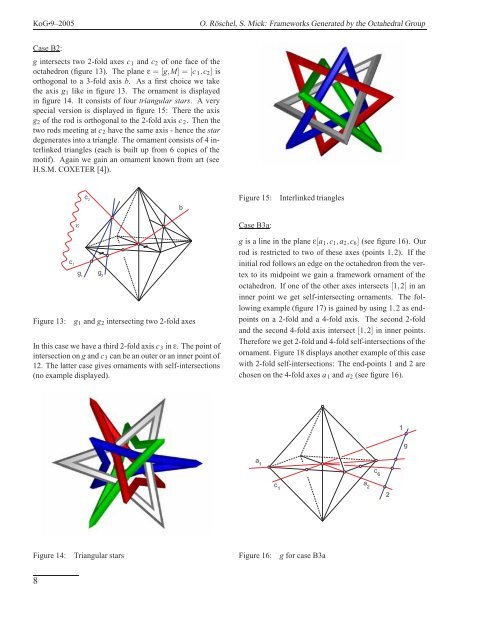Ovaj broj KoG-a u Adobe PDF formatu - hdgg
Ovaj broj KoG-a u Adobe PDF formatu - hdgg
Ovaj broj KoG-a u Adobe PDF formatu - hdgg
Create successful ePaper yourself
Turn your PDF publications into a flip-book with our unique Google optimized e-Paper software.
<strong>KoG</strong> •9–2005 O. Röschel, S. Mick: Frameworks Generated by the Octahedral Group<br />
Case B2:<br />
g intersects two 2-fold axes c1 and c2 of one face of the<br />
octahedron (figure 13). The plane ε =[g,M] =[c1,c2] is<br />
orthogonal to a 3-fold axis b. As a first choice we take<br />
the axis g1 like in figure 13. The ornament is displayed<br />
in figure 14. It consists of four triangular stars. A very<br />
special version is displayed in figure 15: There the axis<br />
g2 of the rod is orthogonal to the 2-fold axis c 2. Then the<br />
two rods meeting at c2 have the same axis - hence the star<br />
degenerates into a triangle. The ornament consists of 4 interlinked<br />
triangles (each is built up from 6 copies of the<br />
motif). Again we gain an ornament known from art (see<br />
H.S.M. COXETER [4]).<br />
<br />
Figure 13: g1 and g2 intersecting two 2-fold axes<br />
In this case we have a third 2-fold axis c3 in ε. The point of<br />
intersection on g and c3 can be an outer or an inner point of<br />
12. The latter case gives ornaments with self-intersections<br />
(no example displayed).<br />
Figure 14: Triangular stars<br />
8<br />
Figure 15: Interlinked triangles<br />
Case B3a:<br />
g is a line in the plane ε[a1,c1,a2,c6] (see figure 16). Our<br />
rod is restricted to two of these axes (points 1,2). If the<br />
initial rod follows an edge on the octahedron from the vertex<br />
to its midpoint we gain a framework ornament of the<br />
octahedron. If one of the other axes intersects [1,2] in an<br />
inner point we get self-intersecting ornaments. The following<br />
example (figure 17) is gained by using 1,2 as endpoints<br />
on a 2-fold and a 4-fold axis. The second 2-fold<br />
and the second 4-fold axis intersect [1,2] in inner points.<br />
Therefore we get 2-fold and 4-fold self-intersections of the<br />
ornament. Figure 18 displays another example of this case<br />
with 2-fold self-intersections: The end-points 1 and 2 are<br />
chosen on the 4-fold axes a1 and a2 (see figure 16).<br />
Figure 16: g for case B3a


